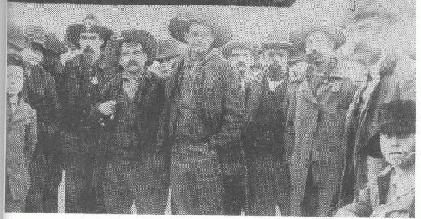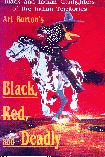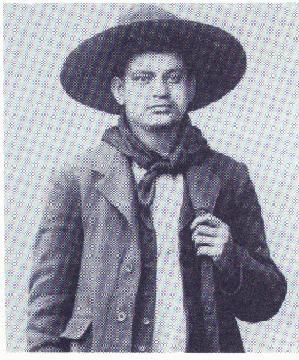| On that date, Lenapah, a little rown on the Kansas & Arkansas Valley
Railroad, later to become the Missouri Pacific, was the scene of the criminal act
which cost Cherokee Bill his life. At that time the principal store in Lenapah
was operated by Schufeldt & Son. John Schufeldt, on the day noted, two men
rode rapidly into Lenapah, from the south, but attracted little attention as their
appearance differed little from the hundreds of cowboys who came there to trade.
Cherokee Bill's first act, after entering the store, was to march John Schufeldt
back to the safe, which he ordered him to open. Quickly securing all the cash
contents, Bill started for the front when he saw the clothing on display in the
rear room of the store, as well as a rack of guns and a shelf of ammunition. He
decided that this was an excellent opportunity to replenish his wardrobe and
pick up a supply of cartridges. Rifle in hand, he forced young Schufeldt into the
rear room and made him lay out the articles he wanted. Schufeldt was no fool. He
knew with whom he was dealing and he did as he was told. A man by the name of
Ernest Melton was doing some work in a vacant lot between the Schufeldt store
and the restaurant next door, the interior of which was being wallpapered. When
Mr. Melton and the other workers heard the shots fired by the outlaws, all rushed
to the windows to see what the noise was about. Cherokee Bill flicked a glance
at the window and saw Melton staring at him. Enraged at the painter's audacity
in spying on him, he threw his rifle to his shoulder and slapped a shot at Melton
that pierced his brain and killed him instantly. After the crime, the outlaws
rode rapidly out of town in the direction from which they had come. This crime
marked the end of the Cooke brothers gang and the end of Cherokee Bill. He was
captured and put on trial and when the verdict was read, Cherokee Bill simply
smiled. But his mother and sister, who were with him in the courtroom throughout
the trail, wept loudly. "What's the matter with you two?" he snapped. "I
ain't dead yet." And that afternoon,at the federal jail, Cherokee Bill "was
engaged in a game of poker with Bill Cook (who had been captured earlier in New
Mexico) and several kindred spirits as if nothing had happened." An appeal
to the Supreme Court by his attorney resulted in the finding of the lower court
being affirmed, and he was resentenced. March 17,1896, was then named as the day
which would end his earthly career. Cherokee Bill was marched to the gallows and
with his mother and Aunty at his side he remarked,"This is about as good a
day to die as any,"...."Goodbye all my chums down that way" ,he
said with a smile. Just then he caught sight of a young man in the act of taking
a snap shot with a Kodak and pulling it sharply back. There was a creaking sound
as the trap was sprung and the body shot downward. The fall was scarcely six
feet, but the rope had been adjusted carefully by Lawson and the neck was broken.
The muscles twisted once or twice, but that was all... Twelve minutes from the
time the trap was sprung, the ropes that bound his limbs were removed, also the
handcuffs and shackles, and the body was lowered into a coffin and borne away and
the crowd dispersed. At Birnie's, the coffin was placed in a box and then taken
to the Missouri Pacific depot and put aboard the train. His mother and sister
took it back with them to Fort Gibson. |

Shortly after his capture, Cherokee Bill posed with his captors at
Wagoner,I.T. Left to right:(5)Zeke Crittenden,(4)Dick Crittenden,Bill,(2)Clint
Scales,(1)Ike Rogers,and (3)Bill Smith. - Courtesy Western History
Collections, University of Oklahoma Library |


